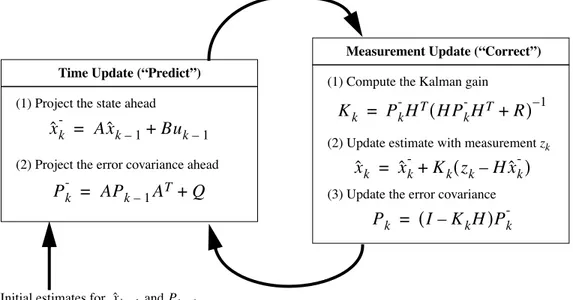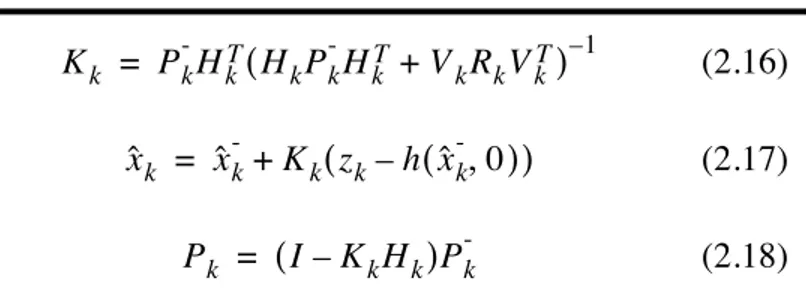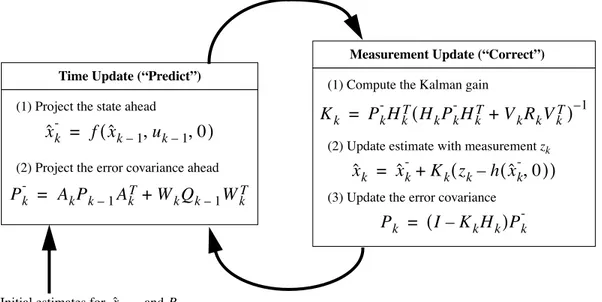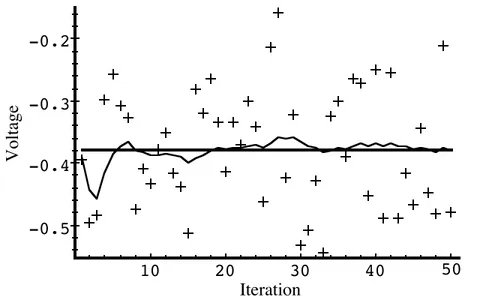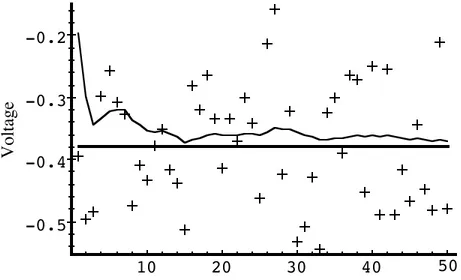An Introduction to the Kalman Filter
Greg Welch1 and Gary Bishop2 TR 95-041
Department of Computer Science University of North Carolina at Chapel Hill
Chapel Hill, NC 27599-3175 Updated: Monday, July 24, 2006
Abstract
In 1960, R.E. Kalman published his famous paper describing a recursive solution to the discrete-data linear filtering problem. Since that time, due in large part to ad-vances in digital computing, the Kalman filter has been the subject of extensive re-search and application, particularly in the area of autonomous or assisted
navigation.
The Kalman filter is a set of mathematical equations that provides an efficient com-putational (recursive) means to estimate the state of a process, in a way that mini-mizes the mean of the squared error. The filter is very powerful in several aspects: it supports estimations of past, present, and even future states, and it can do so even when the precise nature of the modeled system is unknown.
The purpose of this paper is to provide a practical introduction to the discrete Kal-man filter. This introduction includes a description and some discussion of the basic discrete Kalman filter, a derivation, description and some discussion of the extend-ed Kalman filter, and a relatively simple (tangible) example with real numbers & results.
1. [email protected], http://www.cs.unc.edu/~welch 2. [email protected], http://www.cs.unc.edu/~gb
Welch & Bishop, An Introduction to the Kalman Filter 2
1
The Discrete Kalman Filter
In 1960, R.E. Kalman published his famous paper describing a recursive solution to the discrete-data linear filtering problem [Kalman60]. Since that time, due in large part to advances in digital computing, the Kalman filter has been the subject of extensive research and application,
particularly in the area of autonomous or assisted navigation. A very “friendly” introduction to the general idea of the Kalman filter can be found in Chapter 1 of [Maybeck79], while a more complete introductory discussion can be found in [Sorenson70], which also contains some interesting historical narrative. More extensive references include [Gelb74; Grewal93; Maybeck79; Lewis86; Brown92; Jacobs93].
The Process to be Estimated
The Kalman filter addresses the general problem of trying to estimate the state of a discrete-time controlled process that is governed by the linear stochastic difference equation
, (1.1)
with a measurement that is
. (1.2)
The random variables and represent the process and measurement noise (respectively). They are assumed to be independent (of each other), white, and with normal probability distributions
, (1.3)
. (1.4)
In practice, the processnoise covariance and measurement noise covariance matrices might change with each time step or measurement, however here we assume they are constant.
The matrix in the difference equation (1.1) relates the state at the previous time step to the state at the current step , in the absence of either a driving function or process noise. Note that in practice might change with each time step, but here we assume it is constant. The matrix B relates the optional control input to the state x. The matrix in the measurement equation (1.2) relates the state to the measurement zk. In practice might change with each time step or measurement, but here we assume it is constant.
The Computational Origins of the Filter
We define (note the “super minus”) to be our a priori state estimate at step k given knowledge of the process prior to step k, and to be our a posteriori state estimate at step
k given measurement . We can then define a priori and a posteriori estimate errors as
x∈ℜn xk = Axk–1+Buk–1+wk–1 z∈ℜm zk = H xk+vk wk vk p w( )∼N 0 Q( , ) p v( )∼N 0 R( , ) Q R n×n A k–1 k A n×l u∈ℜl m×n H H xˆk- ∈ℜn xˆk∈ℜn zk ek- ≡xk–xˆk-, and ek≡xk–xˆk.
Welch & Bishop, An Introduction to the Kalman Filter 3
The a priori estimate error covariance is then
, (1.5)
and the a posteriori estimate error covariance is
. (1.6)
In deriving the equations for the Kalman filter, we begin with the goal of finding an equation that computes an a posteriori state estimate as a linear combination of an a priori estimate and a weighted difference between an actual measurement and a measurement prediction as shown below in (1.7). Some justification for (1.7) is given in “The Probabilistic Origins of the Filter” found below.
(1.7) The difference in (1.7) is called the measurement innovation, or the residual. The residual reflects the discrepancy between the predicted measurement and the actual measurement . A residual of zero means that the two are in complete agreement.
The matrix K in (1.7) is chosen to be the gain or blending factor that minimizes the a posteriori error covariance (1.6). This minimization can be accomplished by first substituting (1.7) into the above definition for , substituting that into (1.6), performing the indicated expectations, taking the derivative of the trace of the result with respect to K, setting that result equal to zero, and then solving for K. For more details see [Maybeck79; Brown92; Jacobs93]. One form of the resulting K that minimizes (1.6) is given by1
. (1.8)
Looking at (1.8) we see that as the measurement error covariance approaches zero, the gain K
weights the residual more heavily. Specifically, .
On the other hand, as the a priori estimate error covariance approaches zero, the gain K weights the residual less heavily. Specifically,
.
1. All of the Kalman filter equations can be algebraically manipulated into to several forms. Equation (1.8)
represents the Kalman gain in one popular form.
Pk- = E e[ k-ek- T] Pk = E e[ kekT] xˆk xˆk -zk H xˆk -xˆk = xˆk- +K z( k–H xˆk-) zk–H xˆk -( ) H xˆk -zk n×m ek Kk Pk-HT H P k -HT+R ( )–1 = Pk-HT H Pk-HT+R ---= R Kk Rk→0 lim = H–1 Pk -Kk Pk -0 → lim = 0
Another way of thinking about the weighting by K is that as the measurement error covariance approaches zero, the actual measurement is “trusted” more and more, while the predicted measurement is trusted less and less. On the other hand, as the a priori estimate error covariance approaches zero the actual measurement is trusted less and less, while the predicted measurement is trusted more and more.
The Probabilistic Origins of the Filter
The justification for (1.7) is rooted in the probability of the a priori estimate conditioned on all prior measurements (Bayes’ rule). For now let it suffice to point out that the Kalman filter maintains the first two moments of the state distribution,
The a posteriori state estimate (1.7) reflects the mean (the first moment) of the state distribution— it is normally distributed if the conditions of (1.3) and (1.4) are met. The a posteriori estimate error covariance (1.6) reflects the variance of the state distribution (the second non-central moment). In other words,
.
For more details on the probabilistic origins of the Kalman filter, see [Maybeck79; Brown92; Jacobs93].
The Discrete Kalman Filter Algorithm
We will begin this section with a broad overview, covering the “high-level” operation of one form of the discrete Kalman filter (see the previous footnote). After presenting this high-level view, we will narrow the focus to the specific equations and their use in this version of the filter.
The Kalman filter estimates a process by using a form of feedback control: the filter estimates the process state at some time and then obtains feedback in the form of (noisy) measurements. As such, the equations for the Kalman filter fall into two groups: time update equations and measurement
update equations. The time update equations are responsible for projecting forward (in time) the
current state and error covariance estimates to obtain the a priori estimates for the next time step. The measurement update equations are responsible for the feedback—i.e. for incorporating a new measurement into the a priori estimate to obtain an improved a posteriori estimate.
The time update equations can also be thought of as predictor equations, while the measurement update equations can be thought of as corrector equations. Indeed the final estimation algorithm resembles that of a predictor-corrector algorithm for solving numerical problems as shown below in Figure 1-1. R zk H xˆk -Pk- zk H xˆk -xˆk -zk E x[ ]k = xˆk E x[( k–xˆk) x( k–xˆk)T] = Pk. p x( k zk)∼N E x( [ ] E xk , [( k–xˆk) x( k–xˆk)T]) N xˆ( k,Pk). =
Figure 1-1. The ongoing discrete Kalman filter cycle. The time update projects the current state estimate ahead in time. The measurement update adjusts the projected estimate by an actual measurement at that time.
The specific equations for the time and measurement updates are presented below in Table 1-1 and Table 1-2.
Again notice how the time update equations in Table 1-1 project the state and covariance estimates forward from time step to step . and B are from (1.1), while is from (1.3). Initial conditions for the filter are discussed in the earlier references.
The first task during the measurement update is to compute the Kalman gain, . Notice that the equation given here as (1.11) is the same as (1.8). The next step is to actually measure the process to obtain , and then to generate an a posteriori state estimate by incorporating the measurement as in (1.12). Again (1.12) is simply (1.7) repeated here for completeness. The final step is to obtain an a posteriori error covariance estimate via (1.13).
After each time and measurement update pair, the process is repeated with the previous a posteriori estimates used to project or predict the new a priori estimates. This recursive nature is one of the very appealing features of the Kalman filter—it makes practical implementations much more feasible than (for example) an implementation of a Wiener filter [Brown92] which is designed to operate on all of the data directly for each estimate. The Kalman filter instead recursively
conditions the current estimate on all of the past measurements. Figure 1-2 below offers a complete picture of the operation of the filter, combining the high-level diagram of Figure 1-1 with the equations from Table 1-1 and Table 1-2.
Table 1-1: Discrete Kalman filter time update equations. (1.9) (1.10)
Table 1-2: Discrete Kalman filter measurement update equations. (1.11) (1.12) (1.13) Time Update (“Predict”) Measurement Update (“Correct”) xˆk- = Axˆk–1+Buk–1 Pk- = APk–1AT+Q k–1 k A Q Kk Pk-HT H P k -HT+R ( )–1 = xˆk = xˆk- +Kk(zk–H xˆk-) Pk = (I –KkH)Pk -Kk zk
Filter Parameters and Tuning
In the actual implementation of the filter, the measurement noise covariance is usually measured prior to operation of the filter. Measuring the measurement error covariance is generally practical (possible) because we need to be able to measure the process anyway (while operating the filter) so we should generally be able to take some off-line sample measurements in order to determine the variance of the measurement noise.
The determination of the process noise covariance is generally more difficult as we typically do not have the ability to directly observe the process we are estimating. Sometimes a relatively simple (poor) process model can produce acceptable results if one “injects” enough uncertainty into the process via the selection of . Certainly in this case one would hope that the process measurements are reliable.
In either case, whether or not we have a rational basis for choosing the parameters, often times superior filter performance (statistically speaking) can be obtained by tuning the filter parameters
and . The tuning is usually performed off-line, frequently with the help of another (distinct) Kalman filter in a process generally referred to as system identification.
Figure 1-2. A complete picture of the operation of the Kalman filter, com-bining the high-level diagram of Figure 1-1 with the equations from Table 1-1 and Table 1-2.
In closing we note that under conditions where and .are in fact constant, both the estimation error covariance and the Kalman gain will stabilize quickly and then remain constant (see the filter update equations in Figure 1-2). If this is the case, these parameters can be pre-computed by either running the filter off-line, or for example by determining the steady-state value of as described in [Grewal93]. R R Q Q Q R Kk = Pk-HT(H Pk-HT+R)–1
(1) Compute the Kalman gain
xˆk–1
Initial estimates for and Pk–1
xˆk = xˆk- +Kk(zk–H xˆk-)
(2) Update estimate with measurement zk
(3) Update the error covariance
Pk = (I –KkH)Pk
-Measurement Update (“Correct”)
(1) Project the state ahead
(2) Project the error covariance ahead Time Update (“Predict”)
xˆk- = Axˆk–1+Buk–1
Pk- = APk–1AT+Q
Q R
Pk Kk
It is frequently the case however that the measurement error (in particular) does not remain constant. For example, when sighting beacons in our optoelectronic tracker ceiling panels, the noise in measurements of nearby beacons will be smaller than that in far-away beacons. Also, the process noise is sometimes changed dynamically during filter operation—becoming —in order to adjust to different dynamics. For example, in the case of tracking the head of a user of a 3D virtual environment we might reduce the magnitude of if the user seems to be moving slowly, and increase the magnitude if the dynamics start changing rapidly. In such cases might be chosen to account for both uncertainty about the user’s intentions and uncertainty in the model.
2
The Extended Kalman Filter (EKF)
The Process to be Estimated
As described above in section 1, the Kalman filter addresses the general problem of trying to estimate the state of a discrete-time controlled process that is governed by a linear stochastic difference equation. But what happens if the process to be estimated and (or) the measurement relationship to the process is non-linear? Some of the most interesting and successful applications of Kalman filtering have been such situations. A Kalman filter that linearizes about the current mean and covariance is referred to as an extended Kalman filter or EKF.
In something akin to a Taylor series, we can linearize the estimation around the current estimate using the partial derivatives of the process and measurement functions to compute estimates even in the face of non-linear relationships. To do so, we must begin by modifying some of the material presented in section 1. Let us assume that our process again has a state vector , but that the process is now governed by the non-linear stochastic difference equation
, (2.1)
with a measurement that is
, (2.2)
where the random variables and again represent the process and measurement noise as in (1.3) and (1.4). In this case the non-linear function in the difference equation (2.1) relates the state at the previous time step to the state at the current time step . It includes as parameters any driving function and the zero-mean process noise wk. The non-linear function in the measurement equation (2.2) relates the state to the measurement .
In practice of course one does not know the individual values of the noise and at each time step. However, one can approximate the state and measurement vector without them as
(2.3) and
, (2.4)
where is some a posteriori estimate of the state (from a previous time step k).
Q Qk Qk Qk x∈ℜn x∈ℜn xk = f x( k–1,uk–1,wk–1) z∈ℜm zk = h x( k,vk) wk vk f k–1 k uk–1 h xk zk wk vk x˜k = f xˆ( k–1,uk–1,0) z˜k = h x˜( k,0) xˆk
It is important to note that a fundamental flaw of the EKF is that the distributions (or densities in the continuous case) of the various random variables are no longer normal after undergoing their respective nonlinear transformations. The EKF is simply an ad hoc state estimator that only approximates the optimality of Bayes’ rule by linearization. Some interesting work has been done by Julier et al. in developing a variation to the EKF, using methods that preserve the normal distributions throughout the non-linear transformations [Julier96].
The Computational Origins of the Filter
To estimate a process with non-linear difference and measurement relationships, we begin by writing new governing equations that linearize an estimate about (2.3) and (2.4),
, (2.5)
. (2.6)
where
• and are the actual state and measurement vectors,
• and are the approximate state and measurement vectors from (2.3) and (2.4), • is an a posteriori estimate of the state at step k,
• the random variables and represent the process and measurement noise as in (1.3) and (1.4).
• A is the Jacobian matrix of partial derivatives of with respect to x, that is
,
• W is the Jacobian matrix of partial derivatives of with respect to w,
,
• H is the Jacobian matrix of partial derivatives of with respect to x,
,
• V is the Jacobian matrix of partial derivatives of with respect to v,
.
Note that for simplicity in the notation we do not use the time step subscript with the Jacobians , , , and , even though they are in fact different at each time step.
xk≈x˜k+ A x( k–1–xˆk–1)+W wk–1 zk≈z˜k+H x( k–x˜k)+V vk xk zk x˜k z˜k xˆk wk vk f A[i j, ] x[ ]j ∂ ∂ f[ ]i xˆk–1,uk–1,0 ( ) = f W[i j, ] w[ ]j ∂ ∂ f[ ]i xˆk–1,uk–1,0 ( ) = h H[i j, ] x[ ]j ∂ ∂h[ ]i x˜k,0 ( ) = h V[i j, ] v[ ]j ∂ ∂h[ ]i x˜k,0 ( ) = k A W H V
Now we define a new notation for the prediction error,
, (2.7)
and the measurement residual,
. (2.8)
Remember that in practice one does not have access to in (2.7), it is the actual state vector, i.e. the quantity one is trying to estimate. On the other hand, one does have access to in (2.8), it is the actual measurement that one is using to estimate . Using (2.7) and (2.8) we can write governing equations for an error process as
, (2.9)
, (2.10)
where and represent new independent random variables having zero mean and covariance matrices and , with and as in (1.3) and (1.4) respectively.
Notice that the equations (2.9) and (2.10) are linear, and that they closely resemble the difference and measurement equations (1.1) and (1.2) from the discrete Kalman filter. This motivates us to use the actual measurement residual in (2.8) and a second (hypothetical) Kalman filter to estimate the prediction error given by (2.9). This estimate, call it , could then be used along with (2.7) to obtain the a posteriori state estimates for the original non-linear process as
. (2.11)
The random variables of (2.9) and (2.10) have approximately the following probability distributions (see the previous footnote):
Given these approximations and letting the predicted value of be zero, the Kalman filter equation used to estimate is
. (2.12)
By substituting (2.12) back into (2.11) and making use of (2.8) we see that we do not actually need the second (hypothetical) Kalman filter:
(2.13) Equation (2.13) can now be used for the measurement update in the extended Kalman filter, with
and coming from (2.3) and (2.4), and the Kalman gain coming from (1.11) with the appropriate substitution for the measurement error covariance.
e˜x k≡xk–x˜k e˜z k≡zk–z˜k xk zk xk e˜x k≈ A x( k–1–xˆk–1)+εk e˜z k≈H e˜xk+ηk εk ηk WQWT VRVT Q R e˜z k e˜x k eˆk xˆk = x˜k+eˆk p e˜x k ( ) N 0 E e˜x ke˜xk T [ ] , ( ) ∼ p ε( )k ∼N 0 W Q( , kWT) p η( k)∼N 0 V R( , kVT) eˆk eˆk eˆk Kke˜z k = xˆk x˜k Kke˜z k + = x˜k+Kk(zk–z˜k) = x˜k z˜k Kk
The complete set of EKF equations is shown below in Table 2-1 and Table 2-2. Note that we have substituted for to remain consistent with the earlier “super minus” a priori notation, and that we now attach the subscript to the Jacobians , , , and , to reinforce the notion that they are different at (and therefore must be recomputed at) each time step.
As with the basic discrete Kalman filter, the time update equations in Table 2-1 project the state and covariance estimates from the previous time step to the current time step . Again in (2.14) comes from (2.3), and are the process Jacobians at step k, and is the process noise covariance (1.3) at step k.
As with the basic discrete Kalman filter, the measurement update equations in Table 2-2 correct the state and covariance estimates with the measurement . Again in (2.17) comes from (2.4),
and V are the measurement Jacobians at step k, and is the measurement noise covariance (1.4) at step k. (Note we now subscript allowing it to change with each measurement.)
The basic operation of the EKF is the same as the linear discrete Kalman filter as shown in Figure 1-1. Figure 2-1 below offers a complete picture of the operation of the EKF, combining the high-level diagram of Figure 1-1 with the equations from Table 2-1 and Table 2-2.
Table 2-1: EKF time update equations.
(2.14) (2.15)
Table 2-2: EKF measurement update equations. (2.16) (2.17) (2.18) xˆk- x˜k k A W H V xˆk- = f xˆ( k–1,uk–1,0) Pk- AkPk–1AkT W kQk–1WkT + = k–1 k f Ak Wk Qk Kk Pk-HkT H kPk -HkT V kRkVkT + ( )–1 = xˆk = xˆk- +Kk(zk–h xˆ( k-,0)) Pk = (I–KkHk)Pk -zk h Hk Rk R
Figure 2-1. A complete picture of the operation of the extended Kalman fil-ter, combining the high-level diagram of Figure 1-1 with the equations from Table 2-1 and Table 2-2.
An important feature of the EKF is that the Jacobian in the equation for the Kalman gain serves to correctly propagate or “magnify” only the relevant component of the measurement information. For example, if there is not a one-to-one mapping between the measurement and the state via , the Jacobian affects the Kalman gain so that it only magnifies the portion of the residual that does affect the state. Of course if over all measurements there is not a one-to-one mapping between the measurement and the state via , then as you might expect the filter will quickly diverge. In this case the process is unobservable.
3
A Kalman Filter in Action: Estimating a Random Constant
In the previous two sections we presented the basic form for the discrete Kalman filter, and the extended Kalman filter. To help in developing a better feel for the operation and capability of the filter, we present a very simple example here. Andrew Straw has made available a Python/SciPy implementation of this example at http://www.scipy.org/Cookbook/KalmanFiltering (valid link as of July 24, 2006).
The Process Model
In this simple example let us attempt to estimate a scalar random constant, a voltage for example. Let’s assume that we have the ability to take measurements of the constant, but that the
measurements are corrupted by a 0.1 volt RMS white measurement noise (e.g. our analog to digital converter is not very accurate). In this example, our process is governed by the linear difference equation , Kk Pk-HkT H kPk -HkT V kRkVkT + ( )–1 =
(1) Compute the Kalman gain
xˆk = xˆk- +Kk(zk–h xˆ( k-,0))
(2) Update estimate with measurement zk
(3) Update the error covariance
Pk = (I –KkHk)Pk
-Measurement Update (“Correct”)
(1) Project the state ahead
(2) Project the error covariance ahead Time Update (“Predict”)
xˆk- = f xˆ( k–1,uk–1,0) Pk- AkPk–1AkT W kQk–1WkT + = xˆk–1
Initial estimates for and Pk–1
Hk Kk zk h Hk zk–h xˆ( k-,0) zk h xk = Axk–1+Buk–1+wk xk–1+wk =
with a measurement that is
.
The state does not change from step to step so . There is no control input so . Our noisy measurement is of the state directly so . (Notice that we dropped the subscript k in several places because the respective parameters remain constant in our simple model.)
The Filter Equations and Parameters Our time update equations are
, , and our measurement update equations are
, (3.1)
, .
Presuming a very small process variance, we let . (We could certainly let but assuming a small but non-zero value gives us more flexibility in “tuning” the filter as we will demonstrate below.) Let’s assume that from experience we know that the true value of the random constant has a standard normal probability distribution, so we will “seed” our filter with the guess that the constant is 0. In other words, before starting we let .
Similarly we need to choose an initial value for , call it . If we were absolutely certain that our initial state estimate was correct, we would let . However given the
uncertainty in our initial estimate , choosing would cause the filter to initially and always believe . As it turns out, the alternative choice is not critical. We could choose almost any and the filter would eventually converge. We’ll start our filter with .
z∈ℜ1 zk = H xk+vk xk+vk = A = 1 u = 0 H = 1 xˆk- = xˆk–1 Pk- = Pk–1+Q Kk = Pk-(Pk- +R)–1 Pk -Pk- +R ---= xˆk = xˆk- +Kk(zk–xˆk-) Pk = (1 K– k)Pk -Q = 1e 5– Q = 0 xˆk–1 = 0 Pk–1 P0 xˆ0 = 0 P0 = 0 xˆ0 P0 = 0 xˆk = 0 P0≠0 P0 = 1
The Simulations
To begin with, we randomly chose a scalar constant (there is no “hat” on the x because it represents the “truth”). We then simulated 50 distinct measurements that had error normally distributed around zero with a standard deviation of 0.1 (remember we presumed that the measurements are corrupted by a 0.1 volt RMS white measurement noise). We could have generated the individual measurements within the filter loop, but pre-generating the set of 50 measurements allowed me to run several simulations with the same exact measurements (i.e. same measurement noise) so that comparisons between simulations with different parameters would be more meaningful.
In the first simulation we fixed the measurement variance at . Because this is the “true” measurement error variance, we would expect the “best” performance in terms of balancing responsiveness and estimate variance. This will become more evident in the second and third simulation. Figure 3-1 depicts the results of this first simulation. The true value of the random constant is given by the solid line, the noisy measurements by the cross marks, and the filter estimate by the remaining curve.
Figure 3-1. The first simulation: . The true value of the random constant is given by the solid line, the noisy mea-surements by the cross marks, and the filter estimate by the remaining curve.
When considering the choice for above, we mentioned that the choice was not critical as long as because the filter would eventually converge. Below in Figure 3-2 we have plotted the value of versus the iteration. By the 50th iteration, it has settled from the initial (rough) choice of 1 to approximately 0.0002 (Volts2). x = –0.37727 zk R = (0.1)2 = 0.01 x = –0.37727 50 40 30 20 10 -0.2 -0.3 -0.4 -0.5 Iteration Voltage R = (0.1)2 = 0.01 x = –0.37727 P0 P0≠0 Pk
Figure 3-2. After 50 iterations, our initial (rough) error covariance choice of 1 has settled to about 0.0002 (Volts2).
In section 1 under the topic “Filter Parameters and Tuning” we briefly discussed changing or “tuning” the parameters Q and R to obtain different filter performance. In Figure 3 and Figure 3-4 below we can see what happens when R is increased or decreased by a factor of 100 respectively. In Figure 3-3 the filter was told that the measurement variance was 100 times greater (i.e. ) so it was “slower” to believe the measurements.
Figure 3-3. Second simulation: . The filter is slower to respond to the measurements, resulting in reduced estimate variance.
In Figure 3-4 the filter was told that the measurement variance was 100 times smaller (i.e. ) so it was very “quick” to believe the noisy measurements.
50 40 30 20 10 0.01 0.008 0.006 0.004 0.002 Iteration (Voltage) 2 Pk -R = 1 50 40 30 20 10 -0.2 -0.3 -0.4 -0.5 Voltage R = 1 R = 0.0001
Figure 3-4. Third simulation: . The filter responds to measure-ments quickly, increasing the estimate variance.
While the estimation of a constant is relatively straight-forward, it clearly demonstrates the workings of the Kalman filter. In Figure 3-3 in particular the Kalman “filtering” is evident as the estimate appears considerably smoother than the noisy measurements.
50 40 30 20 10 -0.2 -0.3 -0.4 -0.5 Voltage R = 0.0001
References
Brown92 Brown, R. G. and P. Y. C. Hwang. 1992. Introduction to Random Signals
and Applied Kalman Filtering, Second Edition, John Wiley & Sons, Inc.
Gelb74 Gelb, A. 1974. Applied Optimal Estimation, MIT Press, Cambridge, MA. Grewal93 Grewal, Mohinder S., and Angus P. Andrews (1993). Kalman Filtering
The-ory and Practice. Upper Saddle River, NJ USA, Prentice Hall.
Jacobs93 Jacobs, O. L. R. 1993. Introduction to Control Theory, 2nd Edition. Oxford University Press.
Julier96 Julier, Simon and Jeffrey Uhlman. “A General Method of Approximating Nonlinear Transformations of Probability Distributions,” Robotics Re-search Group, Department of Engineering Science, University of Oxford [cited 14 November 1995]. Available from http://www.robots.ox.ac.uk/~si-ju/work/publications/Unscented.zip.
Also see: “A New Approach for Filtering Nonlinear Systems” by S. J. Julier, J. K. Uhlmann, and H. F. Durrant-Whyte, Proceedings of the 1995 Ameri-can Control Conference, Seattle, Washington, Pages:1628-1632. Available from http://www.robots.ox.ac.uk/~siju/work/publications/ACC95_pr.zip. Also see Simon Julier's home page at http://www.robots.ox.ac.uk/~siju/. Kalman60 Kalman, R. E. 1960. “A New Approach to Linear Filtering and Prediction
Problems,” Transaction of the ASME—Journal of Basic Engineering, pp. 35-45 (March 1960).
Lewis86 Lewis, Richard. 1986. Optimal Estimation with an Introduction to
Stochas-tic Control Theory, John Wiley & Sons, Inc.
Maybeck79 Maybeck, Peter S. 1979. Stochastic Models, Estimation, and Control,
Vol-ume 1, Academic Press, Inc.
Sorenson70 Sorenson, H. W. 1970. “Least-Squares estimation: from Gauss to Kalman,”

